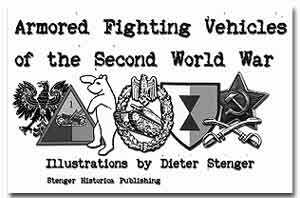Armored
Fighting Vehicles of the Second World War
by Dieter Stenger
$20.00 plus $5 S&H

On Mechanized War
by Erwin Rommel
In mechanized warfare, material attrition and the destruction of the organic cohesion of the opposing army must be the immediate aim of all planning. Tactically, the battle is fought with the highest degree of mobility. The main endeavor should be to concentrate the fighting forces in space and time, while at the same time seeking to split the enemy forces spatially and destroying them at different times. Supply lines are particularly sensitive, since all fuel and ammunition, indispensable requirements for the battle, must pass along them. Hence, everything must be done to protect one's own supply line or to upset, or better still, cut the enemy's. Operations in the enemy's supply area will lead to immediately to his breaking off the battle elsewhere, since supplies are the fundamental premise of the battle and must be given priority of protection. The armor is the core of the mechanized army. Everything turns on it, and other formations are merely auxiliaries. The war of attrition against the enemy armor must therefore be waged, as much as possible, by the anti-tank units. One's own armor should only be used for the final blow. Reconnaissance reports must reach the commander in the shortest possible time; he must make his decisions immediately and put them into effect as soon as possible. Speed of reaction decides the battle. Commanders of mechanized units must therefore operate as near as possible to their troops, and must have the closest possible signal communications with them. Speed of movement and the organizational cohesion of one's own forces are decisive factors and require particular attention. Any sign of dislocation must be dealt with as quickly as possible by reorganization. Concealment of intentions is of the utmost importance in order to provide surprise for one's own operations and thus make it possible to exploit the time taken by the enemy command to react. Deception measures of all kinds should be encouraged, if only to make the enemy commander uncertain and cause him to hesitate and hold back. Once the enemy has been thoroughly beaten, success can be exploited by attempting to overrun and destroy major parts of his disorganized formations. Speed, once again, is everything. The enemy must never be allowed to reorganize. Lighting regrouping for the pursuit and reorganization of supplies for the pursuing forces are essential. Erwin Rommel
Table of
Illustrations
Allied Tanks and Armored Cars
U.S. 75mm M3 Medium "Lee" Tank
U.S. 75mm M8 Light "Stuart" Motor Gun Carriage
U.S. 37mm M8 Light "Greyhound" Armored Car
U.S. 75mm M4A1 Medium "Sherman" Tank
British 6-Pounder MK IV "Churchill" Tank
Soviet 85mm T-34/85 Medium Tank
Soviet 76.2mm KV-1 Heavy Tank
Polish 152mm ISU-152 Self-Propelled Gun
Axis Tanks
and Armored Cars
German 3,7cm Panzerkampfwagen II (Sd Kfz 121)
German 5cm Panzerbefehlswagen III (Sd Kfz 141)
German 7,5cm Panzerkampfwagen IV (Sd Kfz 161/2)
German 7,5cm Panzerbefehlswagen V "Panther" (Pz Bef Wg)
German 7,5cm Panzerjäger "Panther" (Sd Kfz 173)
German 8,8cm Panzerkampfwagen VI "Tiger" (Sd Kfz 181)
German 8,8cm Panzerkampfwagen VI "Königstiger" (Sd Kfz 182)
German 7,5cm Sturmgeschütz (Sd Kfz 142/1)
German 10,5cm Leichte Feldhaubitze "Wespe"(Sd Kfz 124)
German 8,8cm Panzerabwehrkanone 43/1 "Nashorn" (Sd Kfz 164)
German 3,7cm Panzerspähwagen (Sd Kfz 232)
19 plates/illustrations of Axis and Allied vehicles on heavy weight paper. 24 pages.